Registration to our closing conference is now open. Please see the conference page for details.
Category: News
Notes from the NYU Symposium “It’s About Time! Building a New Discipline: Time-Based Media Art Conservation”

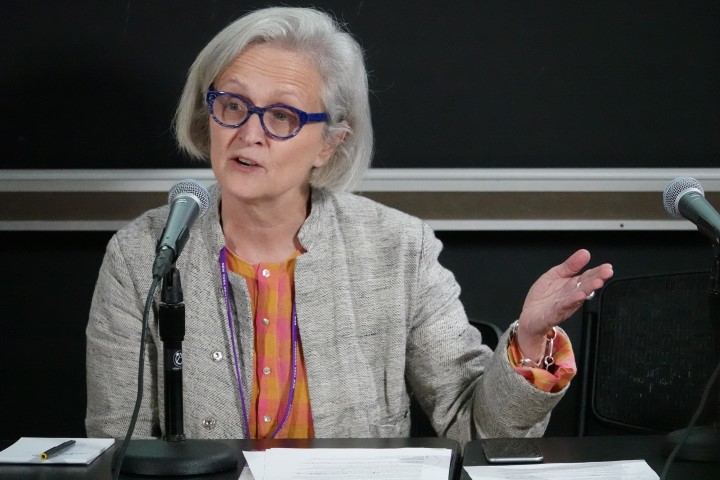

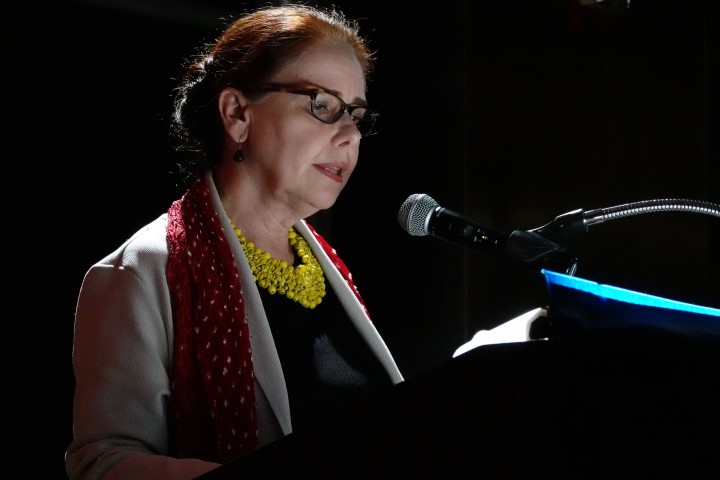
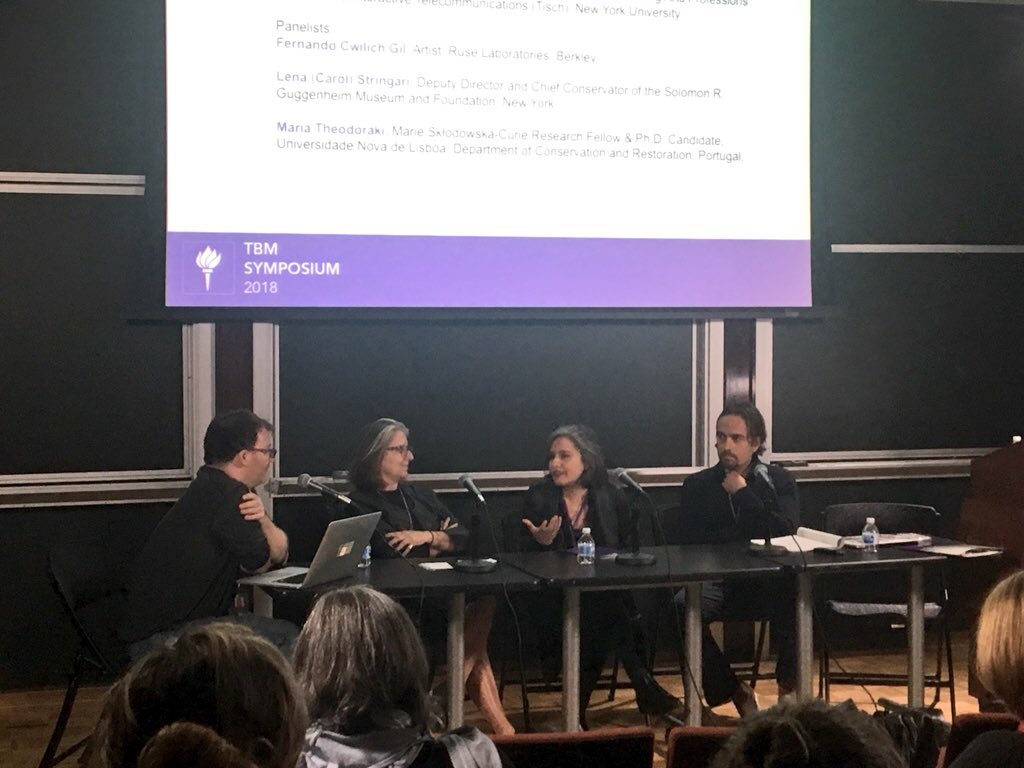 This past May, New York University’s Institute of Fine Arts hosted the symposium “It’s About Time! Building a New Discipline: Time-Based Media Art Conservation” in conjunction with their launch of the first masters-level training specialism in time-based media art conservation in North America. Over two days, an international group of educators, artists, art historians, museum curators and directors, collectors, gallerists, engineers, computer scientists, and conservators convened to discuss, debate, and share perspectives on the state of time-based media art conservation education and practice.
This past May, New York University’s Institute of Fine Arts hosted the symposium “It’s About Time! Building a New Discipline: Time-Based Media Art Conservation” in conjunction with their launch of the first masters-level training specialism in time-based media art conservation in North America. Over two days, an international group of educators, artists, art historians, museum curators and directors, collectors, gallerists, engineers, computer scientists, and conservators convened to discuss, debate, and share perspectives on the state of time-based media art conservation education and practice.
In the first morning session, Christine Frohnert (Bek & Frohnert / NYU IFA) presented a historical overview of time-based media art education. Speakers representing conservation training programs in Berne, Vienna, Amsterdam, Rio de Janeiro, Stuttgart, and NYU shared their varied perspectives on “core competencies” as well as the many challenges they have faced in implementing training programs around time-based media art conservation. Agathe Jarczyk (University of Berne) explained that while skill sets can be deepened with experience, it is the unique role of conservation educators to foster a particular “mindset” in their students. These sentiments were reiterated throughout the symposium; Johannes Gfeller (State Academy of Art and Design, Stuttgart) noted that educators cannot and should not “teach recipes” but instead must arm their students to be critical thinkers and problem solvers. Jonathan Farbowitz (Fellow in the Conservation of Computer-Based Art, Solomon R. Guggenheim Museum) explained how this mindset involves a fundamental curiosity, humility, and aptitude for collaboration, noting the importance of mentorship and constant learning that is critical for time-based media – if not all – art conservators.
Over the course of the second day the institutional challenges posed by time-based media art conservation were discussed in conjunction with ongoing training needs. Iolanda Ratti (Museo del Novecento, Milan) discussed the training gap around contemporary art conservation in Italy, where education is still primarily focused around maintaining the material integrity of physical objects. Curator Lisa Catt and Conservator Asti Sherring (Art Gallery of New South Wales) explained how museums, as “active spaces” contain “objects in motion”; old frameworks focused on medium-specificity and material uniqueness, fail to accommodate artworks where change is an attribute rather than a loss. They advocated for a conservation ethos that centers around asking “what is the artwork?” and emphasizes transparency about artwork change and transformation.
Jo Ana Morfin (Universidad Nacional Autónoma de México) emphasized the importance of “learning by doing with artists,” a notion that was picked up in a round table discussion on the interface between the artist and the conservator. Artist and NACCA PhD researcher Maria Theodoraki (University of Lisbon) expressed her view that conservators must overcome the perceived taboo of working with artists out of a fear that they may exert “influence” and change the work; artworks are ever changing, and conservators, she explained, are expert at interacting with self-awareness and sensitivity.
In a final roundtable, Pip Laurenson (Tate), Tina Rivers Ryan (Albright Knox Art Gallery, Buffalo), Alfredo Salazar-Caro (Digital Museum of Digital Art) and Jill Sterrett (SFMoMA) discussed the “imagined futures” of time-based media art conservation. Sterrett remarked how “we plan for the future but can only really know the present,” stressing the importance of conservation’s role in negotiating between past, present, and future stakeholders. Rivers Ryan pointed to the importance of ruptures in museum structures prompted by works that break conventions and force museums into new directions. Rather than compelling artists and artworks to fit into existing conventions and norms, the tendency of modern and contemporary art to prompt new modes of thinking and doing should be embraced by institutions and be reflected in conservation training programs.
Overall, this symposium highlighted the key role conservation training programs must play in preparing conservators to tackle the unique preservation challenges associated with works of modern and contemporary art. As such, this symposium will undoubtedly be regarded as a major turning point in the history of conservation and the development of the field.
For more information about the symposium, including links to video recordings, please visit: tbmsymposium2018.com.
For information about the NYU Institute of Fine Arts masters-level specialism in time-based media art conservation, please visit: https://www.nyu.edu/gsas/dept/fineart/conservation/time-based-media.htm.
Brian Castriota
Call for papers for upcoming NACCA conference in Glasgow
NACCA is excited to announce a call for papers for our upcoming conference Material Futures: Matter, Memory and Loss in Contemporary Art Production and Preservation. The conference will be held 29th-30th of June, 2017 at the Centre for Contemporary Arts in Glasgow, Scotland. Over two days we will explore the intersections of contemporary artistic practice, curatorial practice, and conservation decision-making through the themes of matter, memory and loss. Please see our call for papers here. Registration information will be forthcoming.
First round of NACCA posters
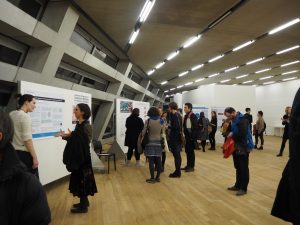
The Authentic Instance: Reframing Authenticity in the Conservation of Contemporary Art
Brian Castriota
Values and Valuation of Modern and Contemporary Visual Art: The Role of Reflective Practice – Collection of the Museum of Art in Lodz, 1931-2018
Joanna Kiliszek
Interpreting Artist’s Intent: The Notion of Intent Tested Against Joseph Beuys’ Capri-Battery
Nina Quabeck
Authenticity and Reproducibility: Conservation Strategies for Contemporary Photography
Marta Garcia Celma
Long-term Preservation of Software-based Artworks: From Single Case Studies to Best Practice
Claudia Roeck
Exploring Ethnography in Conservation Research
Caitlin Spangler-Bickell
Tracing Meanings: The Artist Interview as an Interpretative Tool for the Artwork as an Open-Ended Archive
Aga Wielocha
A Participatory Approach to the Conservation of Performance-based Art
Iona Goldie-Scot
Documentation and Digitization Meet Digital Preservation to Make Time-based Art Last for Posterity
Dušan Barok
The Creative Process is Collective
Sophie Lei
What happens when a work like Equivalent VIII (1966) is presented enclosed within protective barriers?
Maria Theodoraki
Low-level Conflict in Contemporary Art Conservation Research
Zoë Miller
Private Collections as Care-takes
Artemis Rüstau
NACCA public event in London
On the afternoon of Monday 16th January 2017, Tate Modern will host a public event starting at 16:00 when the NACCA researchers will each briefly present on a key message, question or challenge that they wish to communicate about their research. NACCA supervisors and management will attend also and it is our pleasure to be able to invite members of the public to join us.
The presentations will be followed by a networking opportunity during a poster session from 17:45 to 18:45.
The event is free to attend however spaces are limited and we must ask those interested in attending to please register with John McNeill, Tate’s Collection Care Research Manager (john.mcneill@tate.org.uk) by the 9th December 2016 4th January 2017 (deadline extended!).
IIC 2016 Los Angeles Congress – ‘Saving the Now’: Looking back on how much ‘Now’ we have already saved
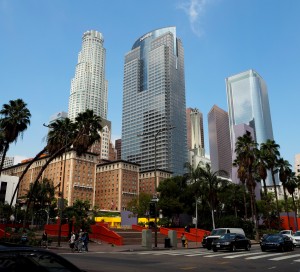
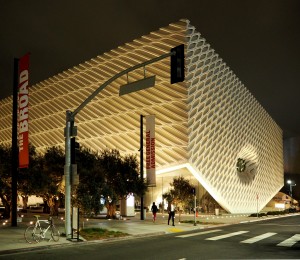
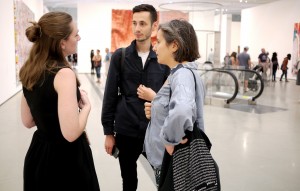
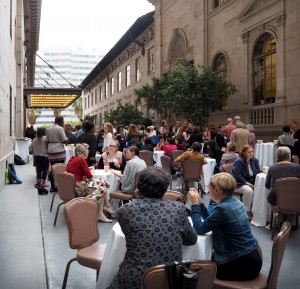
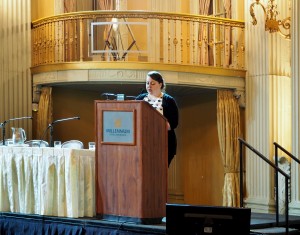
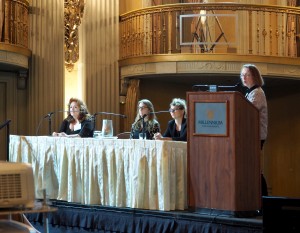
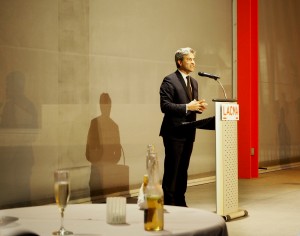

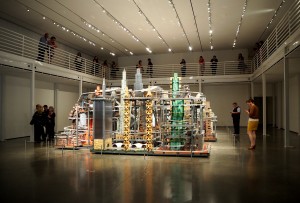
For more than 20 years, the care of contemporary artworks and issues related to their preservation have been subjects in a debate between museum professionals from all over the world. Yet, the field is still developing. Although approaches and procedures are rapidly being discovered and implemented, art practices are constantly changing and new problems continuously appear. The 26th Biennial Congress of the International Institute for Conservation of Historic and Artistic Works (IIC), entitled Saving the Now – Crossing Boundaries to Conserve Contemporary Works, was held between 12 and 16 September in Los Angeles. The congress was a great platform to discuss what has been achieved in the conservation of contemporary art thus far, and to propose what needs to be accomplished in the future.
In his opening speech, Tom Learner, head of contemporary art research at the Getty Conservation Institute, recalled an anecdote related to the first IIC conference devoted to the preservation of twentieth‐century artistic production, which was held 12 years ago in Bilbao. The 2004 IIC congress was entitled ‘Modern Art, New Museums’. The second part of the title was added after the organizing committee showed concern that problems in the conservation of modern art would not be acknowledged as enough of an issue by members of the conservation community to fill the programme of an entire congress. Undoubtedly, much has changed since then. Almost 500 professionals from about 50 different countries came to LA to attend the conference and listen to more than 40 presentations. The history of the field and the evolution of standards and practices were briefly summarized by Lydia Beerkens during the first session. Her presentation showed clearly how the conservation of modern art developed from a case‐by‐case approach into an independent specialization with its own theoretical and ethical framework. The absolute highlight of the first day was the keynote lecture: ‘The falsification of time’ by Carol Mancusi‐Ungaro, who was awarded this year’s Forbes Prize, the highest honour of the IIC. Her presentation was a personal reflection on the philosophical and ethical nuances of conservation from her point of view as one of the pioneers of the field. Many attendees, including myself, are looking forward to reading the lecture on the IIC website.
It’s important to note that, during the conference, the balance between a theoretical approach and material science was aptly maintained. On one hand, Muriel Verbeeck’s lecture, building on a fascinating story of transformations of Anish Kapoor’s Versailles sculpture, presented new conceptual tools for conservation practice. On the other, Yvonne Shashoua summarized the long history of the struggle to preserve artworks with plastic components. There was an opportunity to learn about the application of new mediums in practical treatment, such as agarose gels for cleaning modern paintings in a case study presented by Samantha Skelton. A set of papers was dedicated to exploring the similarities between the conservation of modern and contemporary art and other conservation disciplines, with ethnographic objects and architecture among them.
One of the most anticipated lectures was by Robin Clark and Michelle Barger on the complex new research undertaken by SFMOMA entitled ‘The Artist Initiative’. In this presentation, we heard how issues discussed in the field for so many years have inspired practical solutions in the design of a new museum building. The space between its two‐story conservation studio will serve as an artist archive – a collection of materials and objects used in artist practice related to the SFMOMA collection. The studio includes a special space designed for artists to work together with conservators and curators, equipped with a transparent ‘viewing’ door that can be accessed by the public. Located outside the main museum campus, the Collection Center – a storage place for most of the collection – hosts a workroom, where researchers and the public can study artworks which are not on exhibition. The Mock‐Up Gallery is a life‐size model for a gallery space in the new building, where curators can work together with artists on the design of new shows. Undoubtedly, the SFMOMA project redefines standards in institutional thinking about conservation and documentation of contemporary art. Organizers also invited guests from outside of the conservation microcosm. A stirring lecture on the challenges of collecting and preserving diverse objects, including artworks and memorabilia related to 2014 Ukrainian revolution, was given by Ihor Poshyvailo, the director of The Maidan Museum in Kyiv. The panel on the ‘Influence of the Art Market on Conservation Decisions’ gathered together in one room some of the most prominent representatives of the LA art gallery world. Unfortunately, since the panelists did not attend other lectures, it was more a kind of single‐sided monologue than a real discussion. However, the issue is highly important and under‐debated, and it likely deserves a separate conference.
Besides fascinating lectures, the congress provided countless occasions for intense networking. The daily breakfast allowed attendees to have a morning coffee and make plans for the day together with other colleagues. The welcome reception gave an opportunity for an after‐hours visit to the newly opened, and very impressive, Broad Museum. The emblematic installation of Chris Burden, discussed during the afternoon session, was an extraordinary background for Wednesday’s Grand Event at the Los Angeles County Museum of Art (LACMA). Besides enjoying delicious food, congress participants could learn about the history of famous Los Angeles print workshop in the exhibition ‘The Serial Impulse at Gemini G.E.L.’ and enjoy fabulous works by the most influential American artists ‐ Jasper Johns, Robert Rauschenberg, and Frank Stella, among others. LACMA’s exhibitions were a great introduction to one of Thursday’s tours, entitled ‘Making The Artist’s Vision’. Participants had the unique opportunity to see the facilities of two studios responsible for the fabrication of sculptures by Jonathan Borofsky, Jeff Koons and Ellsworth Kelly. The owners of both companies started their careers in the art world working at the Gemini G.E.L. We were able to see the amazing machinery that allows them to build complicated large‐scale metal constructions, and hear about how important the relationship of trust is between artist and fabricator. Interestingly, one of the most rapidly developing sectors of the field – the conservation of time‐based media – was clearly underrepresented. No lecture was dedicated to the largely unknown territory of born‐digital art. Although object‐based conservation is still a main focus in museums, we should not forget about other artistic practices, especially due to the common fundamental questions concerning the identity and authenticity. Fortunately, this absence had been balanced by lectures on the preservation of other relatively new collectibles, like performance and participatory art. Sill, we have to be careful not to create new boundaries while crossing others.
The congress ended with a pleasant farewell reception at the conference venue. Participants flew home tired but with plenty of new ideas, and their pockets full of business cards from newly met colleagues.
I gratefully acknowledge the financial support of the Brommelle Memorial Fund, which enabled me to attend the conference.
Aga Wielocha
Academic publications on contemporary art conservation in open access
Open access has hit contemporary art preservation and conservation as well. Ever more publications are appearing with free access for all researchers worldwide.
We have compiled a list of English-language monographs, conference proceedings, and journal issues from our field. Currently the list contains fifteen titles, and will be expanded periodically.
Barranha, Helena, and Susana S. Martins (eds.), Uncertain Spaces: Virtual Configurations in Contemporary Art and Museums, Lisbon: Universidade Nova de Lisboa, 2015, 251 pp. Based on the conference produced in the framework of the Unplace project.
PDF
Beerkens, Lydia, and Tom Learner (eds.), Conserving Outdoor Painted Sculpture, Los Angeles: Getty Conservation Institute, 2014, 145 pp. Proceedings from the interim meeting of the Modern Materials and Contemporary Art Working Group of ICOM-CC, Kröller-Müller Museum, Otterlo, 4-5 June 2013.
PDF
Dekker, Annet (ed.), Archive2020: Sustainable Archiving of Born-Digital Cultural Content, Amsterdam: Virtueel Platform, 2010.
PDF
Dekker, Annet ed., Speculative Scenarios, or What Will Happen to Digital Art in the (Near) Future?, Eindhoven: Baltan Laboratories, 2013, 144 pp.
PDF
Depocas, Alain, Jon Ippolito, Caitlin Jones (eds.), Permanence Through Change: The Variable Media Approach, New York: Solomon R. Guggenheim Museum, with Montreal: Daniel Langlois Foundation, 2003, 137 pp. Outcome of the research project Variable Media Network (2001-04).
PDFs
Interventions 4(1): “Object Lesson: Conservation and Contemporary Art”, eds. Anna Linehan and Béatrice Grenier, New York: Columbia University, Jan 2015.
HTML
Lavédrine, Bertrand, Alban Fournier, and Martin Graham (eds.), Preservation of Plastic Artefacts in Museum Collections, Paris: CTHS, 2012, 325 pp. Outcome of POPART project.
PDFs (in respective website sections)
Media-N 11(1): “The Aesthetics of Erasure”, eds. Paul Benzon and Sarah Sweeney, New Media Caucus, 2015.
HTML
Noordegraaf, Julia, et al. (eds.), Preserving and Exhibiting Media Art: Challenges and Perspectives, Amsterdam University Press, 2013, 428 pp. Outcome of the research project (2007-10).
PDF
Revista de historia da arte, 4: “Performing Documentation in the Conservation of Contemporary Art”, eds. Lúcia Almeida Matos, Rita Macedo, and Gunnar Heydenreich, Lisbon: Instituto de História da Arte, 2015, 196 pp. Proceedings of the 2013 conference.
PDF
Reyes-Garcia, Everardo, Pierre Châtel-Innocenti, and Khaldoun Zreik (eds.), Archiving and Questioning Immateriality: Proceedings of the 5th Computer Art Congress, Paris: Europia, 2016, 466 pp.
PDF
Rivenc, Rachel, and Reinhard Bek (eds.), Keep It Moving? Conserving Kinetic Art, Los Angeles: Getty Conservation Institute, 2018. Proceedings from an ICOM-CC MMCA meeting organized in Milan, 2016.
HTML
RTRSRCH 2(2): “
PDF
Scholte, Tatja, and Glenn Wharton (eds.), Inside Installations: Theory and Practice in the Care of Complex Artworks, Amsterdam: University of Amsterdam Press, 2011, 266 pp. Outcome of the Inside Installation project.
PDF
van Saaze, Vivian, Installation Art and the Museum: Presentation and Conservation of Changing Artworks, Amsterdam: University of Amsterdam Press, 2013, 226 pp. Based on author’s dissertation.
PDF
VoCA Journal, ed. Robin Clark, New York: Voices in Contemporary Art, since 2015. Published three times a year.
HTML
Wijers, Gaby, Evert Rodrigo, and Ramon Coelho (eds.), The Sustainability of Video Art: Preservation of Dutch Video Art Collections, Amsterdam: Foundation for the Conservation of Modern Art, 2003, 167 pp. Outcome of the research project Preservation Video Art (2000-03).
PDFs: Part 1, Part 2, Part 3
Do you have any further recommendations? Please leave them in the comments!
New essays by NACCA researchers
Two of our colleagues recently published essays available on the website of Voices in Contemporary Art (VOCA). Caitlin Spangler-Bickell wrote a report from the international symposium “Collecting and Conserving Performance Art” organized by the German Association of Conservators-Restorers at the Kunstmuseum in Wolfsburg, Germany. Maria Theodoraki in her journal article explores the issues related to the mode of address using the case of exhibiting Lygia Clark’s work Bicho (1960).

